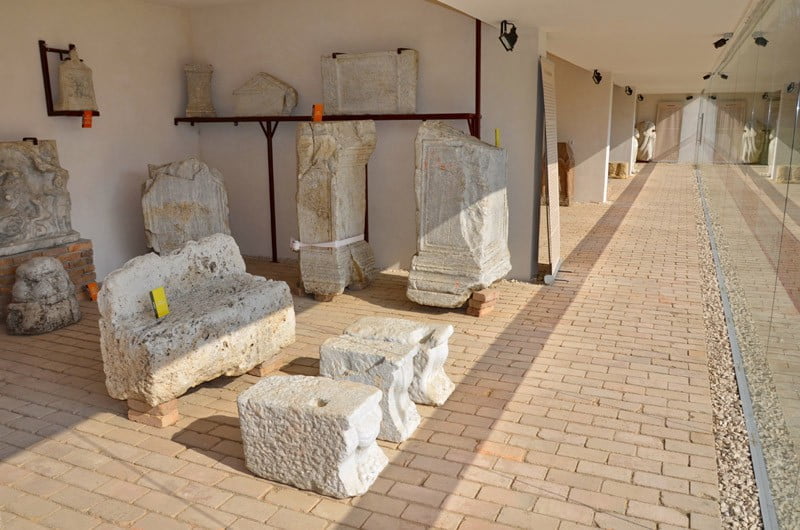Museum in Deva is located at the foot of the Deva Citadel, in the Magna Curia or Bethlen Castle building, as it is also known, and was established in 1882.
Few know that this building, which houses thousands of unique objects, is the oldest historical monument building in Deva, which has won the "battle" with time. In 1998, the building underwent a restoration process that was completed in 2006.
If you arrive in the county seat, a walk in the Cetate Park will lead you to the museum, an imposing building with exceptional architecture. Due to the fact that this building is special and important, a beauty in Baroque style, the building was included on the List of Historical Monuments of category A, meaning historical monuments of national or universal value.


Three sections worth visiting at the Museum of the Dacian and Roman Civilization Deva
Within the institution at the foot of the citadel, there are sections that bring together three important fields, namely: history, art, and natural sciences.
The museum hosts collections of archaeology from the prehistoric, Dacian, Roman, pre-medieval, and early medieval periods, numismatic collections, collections of decorative art, ethnography, such as traditional costumes, tools, Botiza ceramics, glass icons, collections of natural sciences, and a library of approximately 40,000 volumes.






The tombstone houses the most representative pieces of the museum’s patrimony
In the immediate vicinity of the devean museum a permanent exhibition was arranged, in a construction that was realized in 2012. It is regarding Lapidarium, which houses some of the most representative pieces in the museum’s patronage. Some of these objects come from prehistory, the Dacian era and the Roman period. In the courtyard of the museum is reconstructed a set of high stone blocks whose functionality, on a smaller scale, must have been similar to that of the megaliths from Stonehenge (United Kingdom) or Carnac (France).

Brief history of the building
In 1582, the captain of the garrison of the Deva Citadel, Francisc Geszty, built a house on the site of the current monument. This house will later be used as a residence by Sigismund Báthory, General Basta, Ștefan Bocskay, Gabriel Báthory, and Gabriel Bethlen.
In 1621, Gabriel Bethlen ordered the radical transformation of the initial construction, resulting in the Magna Curia palace. After the union of Transylvania with Romania in 1918, Bethlen Castle passed into the possession of the Romanian state, and in 1938, the Hunedoara County History Museum was arranged in the castle.
Lapidarium, the most interesting exhibition of the museum in Deva, contains thousands of stone objects from thousands of years old
The Lapidarium within the Museum of Dacian and Roman Civilization Deva is the place where, if you are passionate about history, you can admire the most representative pieces of lapidary coming from prehistory, the Dacian era and the Roman period, which are in the patrimony of the institution at the foot of the fortress. It is worth mentioning that here is housed the largest collection of Roman statues for women and men in the country.

The representatives of the museum managed to arrange behind the building, from where one can admire the Deva Fortress, one of the most interesting exhibitions of the museum, which was inaugurated in 2012. It contains thousands of stone objects, discovered over the years in the territory of Hunedoara County.

Thus, for several tens of minutes, the “Lapidariu” collection leads you in several worlds, in different forms: from the daily life of the Dacians and the Romans, to the life of the military, through to the last funeral symbols with over 2,000 years.
Within this exhibition was reconstructed an assembly of menhirs, on a smaller scale, whose functionality seems to be similar to that of the megaliths at Stonehenge in the UK or Carnac in France. Among these objects, there are four megalithic pieces, three of them being discovered in 1881, in the area of Baia de Criș and Țebea. The specialists say that these objects were, most likely, funerary stones, from the Bronze Age, being less commonly found in Romania.

Also exhibited here are objects discovered after the archaeological excavations in the Orăștiei Mountains, in the area of the Dacian fortresses. More precisely, it is about blocks with cartridges and letters or with groups of Greek letters, which could mean that the Greeks and Romanians could have coordinated the construction of the Dacian fortresses.
In the exhibition in the courtyard of the Magna Curia Palace, there are also exhibited objects that belonged to the Romans, discovered on the site of Ulpia Traiana Sarmizegetusa, such as the inscriptions and reliefs in marble, a mythical sheet, on which is represented the Iranian god Mithras killing a bull. Also, there is exhibited an unique inscription in the Latin and Greek languages, which was discovered in Germisara, in Geoagiu Băi.

Even the military life has its corner in this exhibition. This is represented, among others, by military statues, but also by funeral monuments, most probably made in their honor.

Some stone objects from the category of funerary art, representing stars, a funeral lion, even a sarcophagus with the reconstruction of a female tomb, discovered in Micia are exhibited here.



There are thousands of stone objects that have waited for hundreds or thousands of years to be rediscovered and returned to people who long for knowledge of the past.
Visiting hours: Summer schedule: Tuesday - Sunday: 10:00 am - 6:00 pm (ticket office closes at 5:30 pm) Winter schedule: Tuesday - Sunday: 9:00 am - 5:00 pm (ticket office closes at 4:30 pm) The museum is closed every Monday.
More info on www.mcdr.ro





